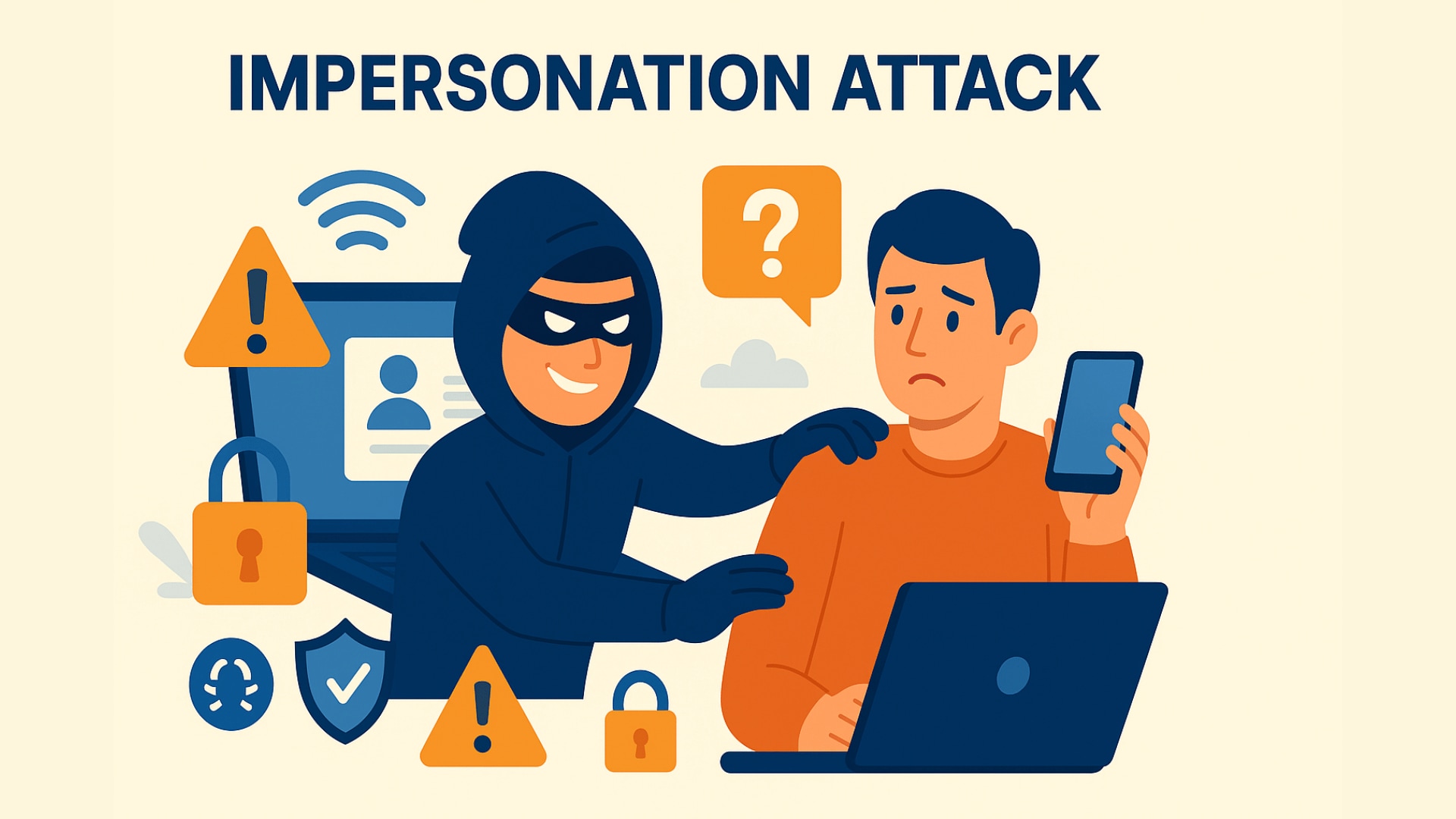
Impersonation attacks have become a major cybersecurity concern, targeting individuals and organizations by mimicking trusted identities. Unlike technical hacks that exploit software flaws, these attacks manipulate human behavior and trust to achieve malicious goals. Recognizing how they operate, their consequences, and how to mitigate them is crucial for those managing digital environments.
Table of contents
Understanding Impersonation Attacks
An impersonation attack involves a cybercriminal pretending to be a credible figure or entity to deceive someone into performing actions that benefit the attacker. This might mean posing as a company executive, business partner, bank representative, or well-known service provider. These manipulations aim to extract sensitive information, gain access to secure systems, or prompt fraudulent financial transactions. At their core, impersonation attacks are social engineering tactics that exploit human tendencies rather than technical flaws.
How Do These Attacks Unfold?
The process behind an impersonation attack is methodical and premeditated. It begins with careful research, during which attackers gather information about their targets from public sources like social media, company websites, and online directories. This information helps create a believable persona.
Once enough details are collected, the attacker crafts their impersonation. They might design convincing emails, clone social profiles, or set up websites that closely resemble legitimate ones. Often, they register domains with subtle misspellings or variations to make them look authentic.
Next comes engagement. The attacker reaches out under the guise of a trusted source, frequently framing the message as urgent to create pressure. These messages might request payments, credentials, or the opening of a suspicious attachment or link.
If successful, the victim is misled into performing the desired action — such as transferring money or disclosing confidential information. The attacker can then use this data for financial gain, further attacks, or resale on the dark web.
Why Impersonation Attacks Matter
The implications of a successful impersonation attack extend well beyond financial damage. While businesses may experience unauthorized transactions and recovery costs, individuals could see their bank accounts compromised or personal identities misused.
Beyond monetary consequences, reputational harm can be significant. A company caught in an impersonation scam may lose customer trust and face public scrutiny. Sensitive data leaks can also result in legal challenges and regulatory penalties. Furthermore, the emotional toll on victims — ranging from anxiety to a breakdown in professional relationships — is not to be underestimated.
Common Forms of Impersonation Attacks
Impersonation schemes take many forms, each tailored to exploit trust and human behavior in different ways. The most prevalent types include:
- Email Impersonation
Attackers mimic trusted contacts or brands using lookalike addresses and convincing language. These emails often include urgent requests for credentials, invoices, or file access. - Executive Impersonation (CEO Fraud)
Cybercriminals pose as high-level executives—such as a CEO or CFO—to pressure employees into transferring funds or disclosing confidential data. - Whaling
A highly targeted variant of spear-phishing, whaling focuses on senior executives or key decision-makers. These attacks are often customized and extremely convincing, aiming for maximum impact. - Cousin Domain Attacks
Fake domains that closely resemble real ones (e.g., swapping letters or using different top-level domains) are used to trick recipients into trusting deceptive messages. - Envelope Impersonation
This method alters the email’s metadata to make it appear as though it comes from a legitimate sender, bypassing basic security filters. - Account Takeover (ATO)
Once attackers gain access to a real user’s account, they use it to send malicious communications that appear fully authentic. - Smishing and Vishing
These mobile-based attacks use text messages or voice calls to impersonate banks, service providers, or officials in an attempt to extract sensitive data. - Man-in-the-Middle (MITM) Attacks
In these sophisticated schemes, the attacker secretly intercepts and alters communications between two parties, capturing sensitive data in real time. - Brand Impersonation
Fraudsters replicate legitimate company branding across emails, websites, or social media platforms to mislead users and collect credentials or payment info.
How to Spot an Impersonation Attempt
Detecting these scams demands a keen eye and critical thinking. Start by scrutinizing email addresses and domain names. Even slight variations should prompt suspicion. For web links, ensure the address begins with “https://” and check for the padlock symbol.
Be wary of unexpected or urgent requests, especially from high-ranking individuals. These tactics are designed to override your usual verification processes. Always double-check through alternate communication channels before acting.
Technical clues can also help. Reputable organizations implement email authentication methods like SPF, DKIM, and DMARC. Their absence can be a warning sign. Similarly, inconsistencies in writing style, grammar, or tone should raise doubts.
Ultimately, if a message feels unexpected or pushes for confidential data or financial action, take a step back. Consult internal teams or verified contacts to confirm legitimacy.
Building Resilience Against Impersonation Threats
Preventing impersonation attacks requires more than just firewalls and filters. Human awareness is the first line of defense. Regular training programs can empower employees to recognize suspicious messages, question urgent demands, and follow secure procedures.
Strong email authentication is another must. SPF, DKIM, and DMARC help email servers identify genuine senders and reject forgeries. Together, these tools dramatically reduce the risk of spoofing.
Advanced security platforms can offer additional protection. These solutions use machine learning and real-time intelligence to flag suspicious activity. Some can even spot nuanced impersonation attempts using AI-driven detection systems.
Monitoring domains similar to your own can also help identify emerging threats. Registering obvious misspellings and variations of your company’s domain prevents attackers from exploiting them.
For high-risk actions like financial transactions, consider implementing dual-control processes. This ensures that no single person can authorize transfers or sensitive operations without a second verifier.
Finally, encourage prompt reporting of suspicious activity. Early detection can stop an attack in its tracks, while shared intelligence helps strengthen defenses across the organization.
Conclusion
Impersonation attacks thrive on trust, targeting people rather than systems. These scams are sophisticated, evolving, and often difficult to detect. But with the right mix of education, authentication, monitoring, and response protocols, organizations can dramatically reduce their vulnerability.
And as impersonation tactics grow more automated, defending against them includes distinguishing between legitimate users and bots. Our team at captcha.eu offers GDPR-compliant CAPTCHA solutions that protect your digital assets by ensuring that access is granted only to real human users — safeguarding your website from impersonation, bots, and automated threats alike.
FAQ – Frequently Asked Questions
What is an impersonation attack in cybersecurity?
An impersonation attack is a social engineering tactic where a cybercriminal pretends to be a trusted individual or organization — such as a CEO, bank or vendor — to trick victims into revealing confidential data, transferring money, or granting access to systems.
How do attackers impersonate others?
Attackers gather public information to create convincing fake identities or domains. They use email spoofing, fake social profiles, or phone calls to impersonate authority figures, making their requests seem legitimate and urgent.
What is the difference between spoofing and impersonation?
Spoofing refers to technically faking information such as email headers or IP addresses. Impersonation, on the other hand, focuses on mimicking the identity, tone, and behavior of a trusted entity to deceive the target — often using spoofing as one method of execution.
How can I protect my organization from impersonation attacks?
Implement email authentication protocols (SPF, DKIM, DMARC), provide regular security training, use dual-approval processes for financial transactions, monitor domain variations, and deploy advanced email security tools with AI-based threat detection.
Can CAPTCHA help prevent impersonation attacks?
Yes. While CAPTCHA doesn’t stop impersonation directly, it prevents automated bots from launching impersonation-based phishing campaigns at scale. At captcha.eu, our GDPR-compliant CAPTCHA solutions help block fake sign-ups, credential stuffing and bot-driven social engineering attempts.
100 free requests
You have the opportunity to test and try our product with 100 free requests.
If you have any questions
Contact us
Our support team is available to assist you.




